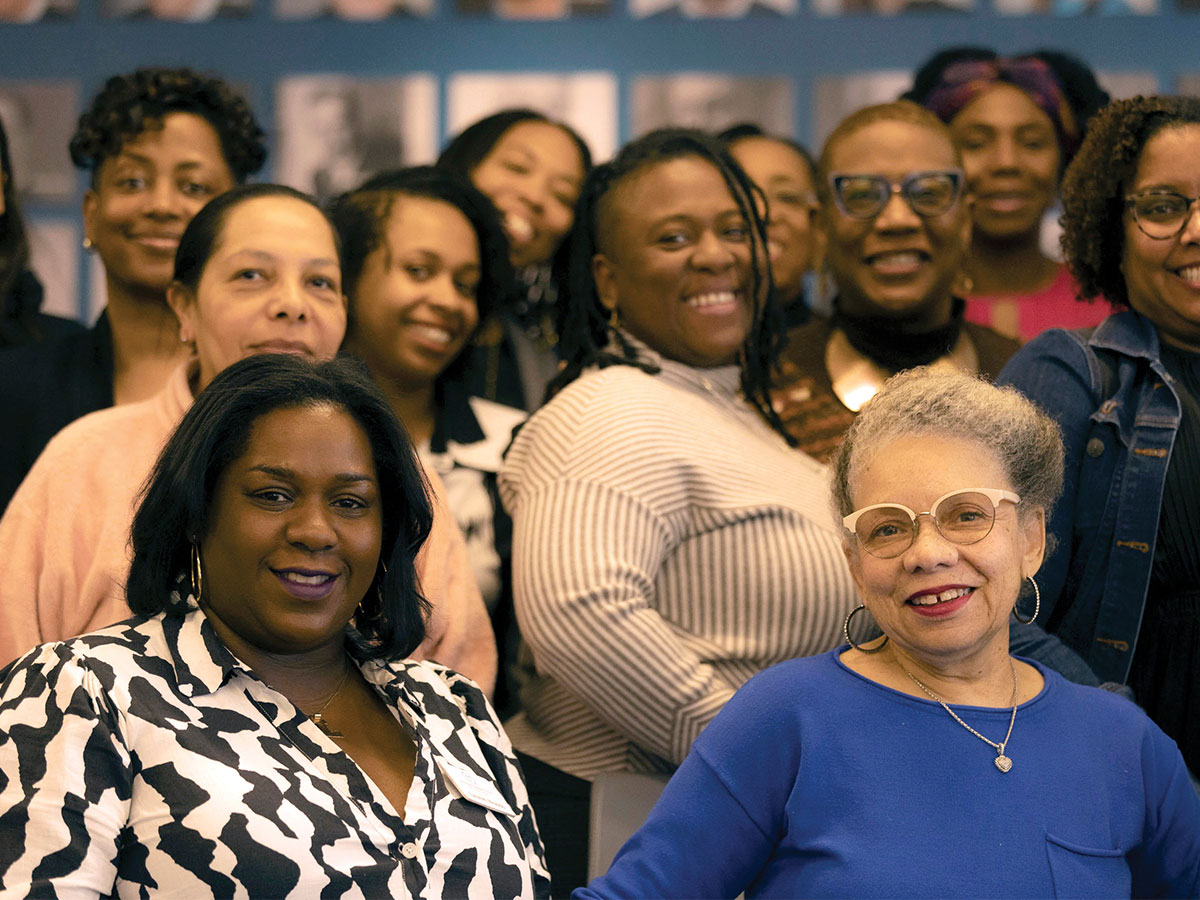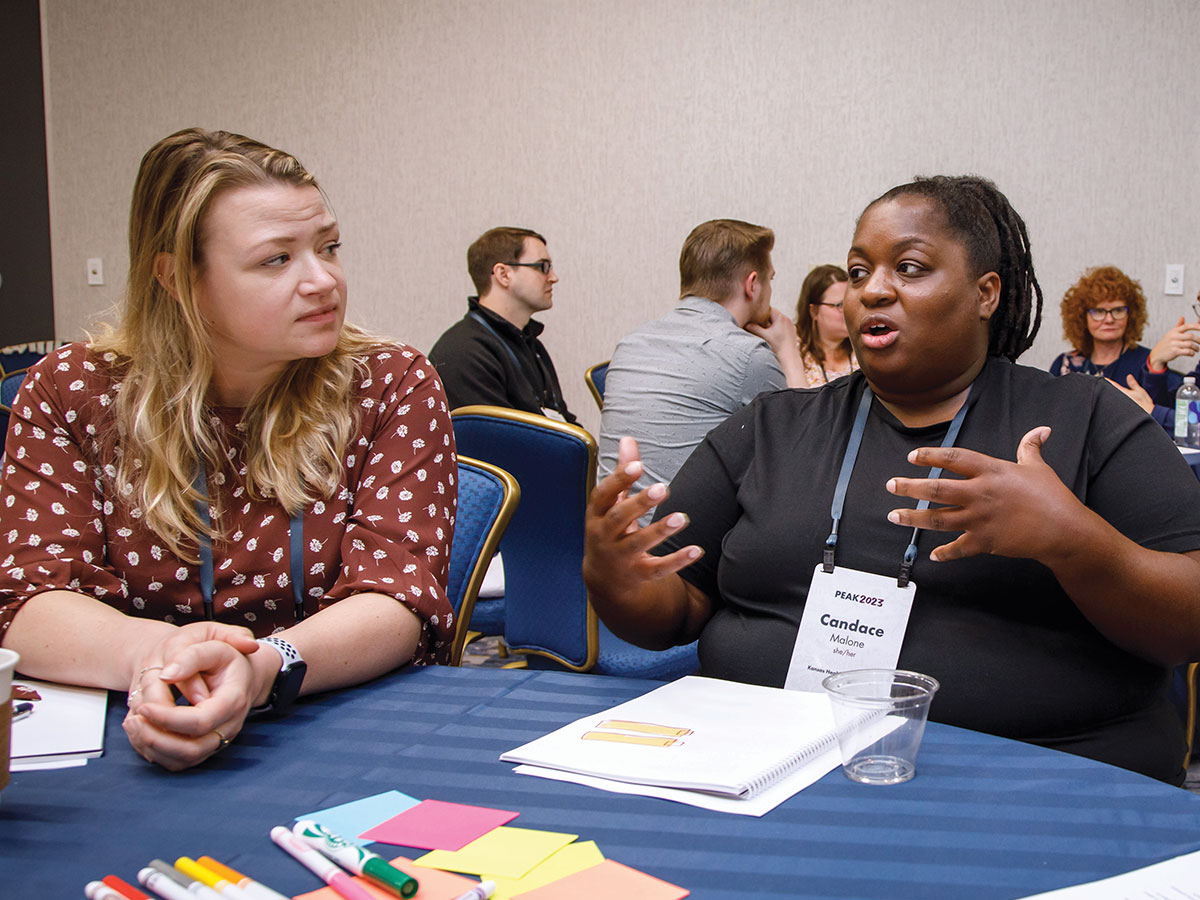
Technology has been central to the shifts we have made to weather the pandemic: Work, school, and social gatherings moved online virtually overnight, and organizations had to ensure they too were prepared to navigate and thrive in a tech-dependent world. And while the shift to digital has been ongoing – in fact, PEAK members have been in the vanguard of adopting and adapting digital grantmaking systems and processes for years – 2020 intensified the pace of change and the urgency around conversations about the intersection between technology and equity.
To facilitate some of these important conversations and build a movement of tech futurists leveraging technology to advance equity and justice, PEAK partnered with Technology Association of Grantmakers, GrantAdvisor, and Grantbook to present a dynamic four-part Philanthropy, Tech & Equity learning series in late 2020. Structured around the components of building a social movement, the sessions tackled four themes: Start with Community. Understand the Context. Apply an Equity Lens. Develop Shared Vision.
Here, we summarize some key takeaways from each of the four sessions, providing links to the on-demand webinars for our members, along with resources recommended by the panelists.
If you are a tech futurist, ready to co-create a grantmaking future that uses technology to advance equity and justice, join us at PEAK2021 Online where we will continue this discussion.
Session 1:
Listening to Stakeholders: Focus on Nonprofit User Experience
Panelists:
- Kari Aanestad, Co-Director, GrantAdvisor and Director of Advancement, Minnesota Council of Nonprofits
- James Law, Director, Innovation & Business Development, Grantbook
- Rhonda McGee, Information Systems Manager, Kalamazoo Foundation
The first key principle of social justice work: Start with community. The series kicked off by centering the user experiences of non-profits, the primary beneficiaries of philanthropy tech. Online grants management systems can be effective tools for grantmakers to streamline processes and increase efficiency but can also unintentionally create barriers for non-profits who don’t have the time or expertise to navigate complicated systems.
GrantAdvisor, an anonymous tool where nonprofits can leave feedback for their funders, has been tracking what aspects of online systems and processes create pain points for nonprofits, and these and other user insights can help us design systems and processes that advance both equity and efficiency, neither at the expense of the other. After all, as panelist Kari Aanestad reminded us with a quote from W. Edwards Deming: “Every system is perfectly designed to get the result that it does.”
Some key insights and recommendations from our panelists include:
- Ask for honest feedback about your systems from your applicants and grantees and listen carefully to their responses. If you are asking nonprofits to spend considerable time or energy to help you improve your systems, however, you are essentially asking them to serve as consultants and should compensate them for their expertise.
- The number one, most oft-cited pain point for nonprofits is word and character limits in online philanthropy tech. Offering guidance on recommended word counts without including hard limits in the system is a small technical change that can have a huge positive impact for your users.
- Always start with relationship-building and listening, and be open to right-sizing your systems and processes to meet nonprofits where they are. Are your systems mobile-friendly, in case an organization doesn’t have easy access to a computer and internet? Do you only accept information through your online system or are you open to other methods? If so, is that flexibility clear to potential grantees?
- Recommended barrier reduction strategies from GrantAdvisor include:
- Active listening and community engagement
- Test your own application process first
- Collaborate to adopt common elements (eg. demographic fields)
- Reduce fields and streamline efficiency
- Use information that’s publicly available
- Show continued flexibility (general operating support, minimum reporting)
- Mind the impact of “required fields”
- Get rid of word/character limits forever
- Remember that “information and insights are two different things” – Rhonda McGee
Related resources:
- Watch the on-demand webinar here
- Principles for Peak Grantmaking: Narrow the Power Gap Resources
- GrantAdvisor.org
Session 2:
The State of Philanthropy Tech: Understanding the Landscape
Panelists:
- Chantal Forster, Executive Director, Technology Association of Grantmakers
- Wendye Mingo, Managing Director, Information Technology, Kresge Foundation
- Amadie Hart, President, Hart Strategic Consulting LLC
- Chris Worman, Vice President of Alliances and Program Development, TechSoup
Another key principle in social justice work is to understand the context in which you are working and trying to make change. In this session, TAG’s Chantal Forster shared insights from their 2020 State of Phialnthropy Tech report, Amadie Hart shared key takeaways from Idealware’s research for the 2020 Consumers Guide to Grants Management Systems, and panelists discussed the latest technology practices, tools, and perceptions in philanthropy; DEI practices; and technology strategy and budget updates due to COVID-19.
TAG’s report, based on a survey of 233 foundations, included several notable findings, including:
- In response to the pandemic, organizations are supporting grantees in many new ways, including streamlining applications (61%), moving to paperless payments (51%), and streamlining reporting (47%). Organizations also indicate a new willingness to provide technology tools (22%) and technology training or support (28%) to grantees.
- Foundations transitioned their own teams to remote working, and 51% expect to increase their organization’s technology budget in 2021.
- 37% of respondents offered no DEI training and 40% offered no DEI programs for tech teams, indicating a lack of organizational commitment to DEI training and programming generally, a lack of considering tech teams as strategic partners in advancing DEI, or both.
- Promisingly, the survey revealed an important correlation between the 12% of organizations with programs to “develop a pipeline of diverse leaders” and those with multiple DEI programs, showing an emerging maturity model for the work of DEI in organizations. Organizations with a commitment to develop a pipeline of diverse leaders have moved beyond “checking a box” by recruiting diverse candidates and additionally have developed a commitment to deeper equity and inclusion at the leadership level and more.
Related resources:
- Watch the on-demand webinar here
- 2020 State of Philanthropy Tech (Technology Association of Grantmakers)
- 2020 Consumers Guide to Grants Management Systems (Idealware)
Session 3:
Equitable Tech: How Technology and Data Impact Equitable Outcomes
Panelists:
- TeQuion Brookins, Director of Operations, McGregor Fund
- Carly Hare, National Director/Coalition Catalyst, CHANGE Philanthropy
- Rebecca Van Sickle, Managing Partner, 1892 Consulting
Principle #3 in social justice work: Apply an equity lens. Or, even better, get that equity Lasik. Once we understand our community and the landscape we work within, we need to start asking some tough questions. This session explored the ways that technology and data can help – or hinder – our equity goals and offered concrete action steps for examining organizational technology frames.
Philanthropy technology and data can be used to support equity through streamlined processes, easier information sharing, integrated systems, and common profiles and/or applications to reduce burdens on nonprofits. Tech and data can also help us understand better the scope of the injustices we hope to address and increase transparency and trust between grantmakers and nonprofits.
However, technology can also create barriers: AI and data can perpetuate bias, and the overall professionalization of the sector can alienate grassroots, community organizations and perpetuate white supremacist norms. The data gathered by grantmakers is also too often extractive, used to aid decision-making within foundations but not shared back with communities for them to use in strategic ways.
A few key insights and recommendations from our panelists include:
- Reduce the burden on grantees and implement more flexible practices, such as replacing reports with conversations and site visits, recording a zoom conversation and attaching the zoom conversation as the report, capturing lessons learned during conversations with grantees and using an AI to pull out themes.
- Reimburse nonprofits for time spent applying for grants and/or resourcing all grantees to update their profiles.
- Engage IT, data teams, grants management, knowledge managers, evaluation and learning staff in personal and work-related equity practice.
Related resources:
- Watch the on-demand webinar here
- Principles for Peak Grantmaking: Drive Equity resources
- What is Your 2021 Equity Pledge? How to Operationalize Equity in Philanthropy
- Equitable Evaluation Initiative
- CHANGE Philanthropy & CHANGE partners:
- Asian Americans/Pacific Islanders in Philanthropy
- ABFE: A Philanthropic Partnership for Black Communities
- Emerging Practitioners in Philanthropy
- Funders for LGBTQ Issues
- Hispanics in Philanthropy
- Native Americans in Philanthropy
- National Committee for Responsive Philanthropy
- Neighborhood Funders Group
- Philanthropic Initiative for Racial Equity
- Women’s Funding Network
Session 4:
The Future of Tech in Philanthropy: Building a Robust Digital Infrastructure with TAG and Tech Futurists
Panelists:
- Sam Caplan, Strategic Advisor to TAG and Founder, New Spark Strategy
- Adam Liebling, Director, Grants Management, Robert Wood Johnson Foundation
- Iara Peng, Founder, JustFund Portal
The final key principle for social justice work is to develop a shared vision. In the series close-out, our panel of tech futurists imagine what we could co-create, with user experience and equity at the forefront. How can emerging tech play a role in a new infrastructure for civil society and how we can ensure it is built in an ethical and equitable way? Building equitable systems requires that the people coding, building and testing systems, and analyzing system data are diverse and representative, with BIPOC and women at the forefront.
We also learned about JustFund, the first giving portal of its kind using a common proposal with just four core questions to connect funders with frontline organizations, and discussed the role that trust-based philanthropy plays in the future of grantmaking.
This session challenged us all to think about our roles in within philanthropy and how we can strategically use those roles to build a more just and equitable world. PEAK’s tent has grown, and there is an incredible opportunity to highlight the value of IT and grants management as strategic thinkers and partners coming together to lift each other up and invite each other into the room. Philanthropy is at a crossroads, and PEAK members can use their expertise to step into the gap between operationalizing equity and values. This session reminded us that the future doesn’t just happen to us: WE build the future and have the opportunity to build the future we want.
Related resources:
- Watch the on-demand webinar here
- JustFund
- Trust-Based Philanthropy Project
- Roadmap for Funders: Investing in Digital Infrastructure (Technology Association of Grantmakers)
- “Strategic Role of Technology in Philanthropy” series (Technology Association of Grantmakers)



